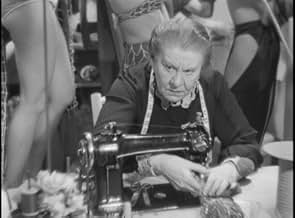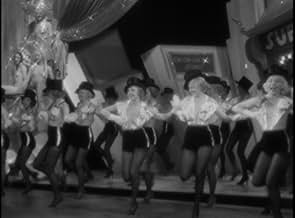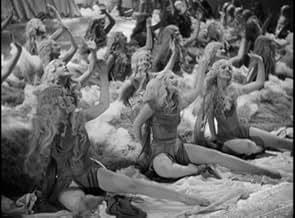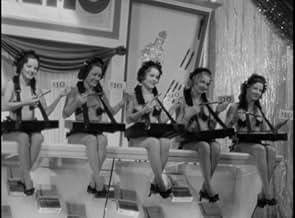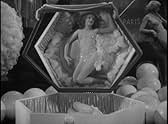A homicide detective with an eye for the ladies, investigating a murder in Earl Carroll's Vanities, allows the music revue to continue during the investigation.A homicide detective with an eye for the ladies, investigating a murder in Earl Carroll's Vanities, allows the music revue to continue during the investigation.A homicide detective with an eye for the ladies, investigating a murder in Earl Carroll's Vanities, allows the music revue to continue during the investigation.
- Awards
- 1 win total
Charles Middleton
- Homer Boothby
- (as Charles B. Middleton)
Ernestine Anderson
- Earl Carroll Girl
- (uncredited)
Lona Andre
- Lona - Earl Carroll Girl
- (uncredited)
William Arnold
- Treasurer
- (uncredited)
Lucille Ball
- Earl Carroll Girl
- (uncredited)
Featured reviews
Released just before the Production Code crackdown in July, 1934, Mitch Leisen's all-star Paramount musical is both leeringly suggestive -some even claim misogynistic- and a heck of a lot of fun. Two murders occur on the opening night of "Earl Carroll's Vanities" (one on-stage), but that doesn't stop the manager (Jack Oakie) from putting on a show as a lascivious police detective (Victor McLaglen) investigates. Everyone is hiding something and Gypsy Rose Lee must have seen this backstage murder mystery before she penned "The G-String Murders" as the denouement is similar, albeit more satisfying here. Gertrude Michael, as a vicious diva, stops the show (in more ways than one) with her exotic "Sweet Marijuana" number and Duke Ellington finishes with the truncated "Rape Of The Rhapsody". The hit song, "Cocktails For Two", also came from this bizarre and bawdy camp classic. Here's Louella O. Parsons in the "Los Angeles Examiner" on May 17, 1934:
Earl Carroll's hand-picked beauties' pirouette about on the Grauman United Artists screen in a fig leaf and not much else. But September Morn herself never had a better figure than these charmers, who are made up to please the eye, especially the eye of the tired businessman. But don't for a moment think Mr. Carroll's girls, au naturelle, are the only attraction. Believe it or not, MURDER AT THE VANITIES is a musical comedy thriller, if you know what I mean -a murder mystery incorporated in a musical show. It all happens on the opening night at the time the play is in progress and a search is on for a murderer. Just by way of suspense, a cop threatens to stop the show every few minutes. Victor McLaglen is something new in cops. All the time he is trying to track down the murderer, he keeps his eye fastened on the chorus beauties. The murder mystery is good with the exception of the denouement, which is pretty flat. Probably faulty direction. Dorothy Stickney, who plays the maid, is about as melodramatic as the heroine in a ten, twenty, and thirty show. For no good reason, she rates a never-ending closeup in the big dramatic scene. The girl ensembles are good, and it's a positive relief to get away from the inevitable overhead shots. The costumes are beautiful; in fact, this is a musical that Paramount can feel is really to their credit. As for Carl Brisson -well, he would be an addition to any show. Good-looking with a delightful singing voice and an easy, assured manner, he is all his press agents claim for him. I also like Kitty Carlisle, who plays the leading lady in the show. Gertrude Michael, as the deep-eyed villainess, gives an interesting if rather fictional portrayal. Jack Oakie, as the stage manager, is the same old wisecracking Jack, but we wouldn't change him. Jessie Ralph is excellent as the seamstress. Others in the cast are Charles Middleton, Gail Patrick, Donald Meek, Barbara Fritchie, Toby Wing and Lona Andre. The screen play is by Carey Wilson and Rufus King, and the direction by Mitchell Leisen. The music is by Arthur Johnstone and the lyrics by Sam Coslow. In addition to MURDER AT THE VANITIES, there is a Mickey Mouse cartoon, a Paramount Newsreel, and a two-reeler, THE WRONG DIRECTION.
I disagree with Lolly on the denouement, it's satisfying if over-the-top. Why would she blame the director? Was she displeased with the story's ending -or the way it was staged? And what's a "ten, twenty, or thirty show"? Note the swipe taken at Busby Berkeley and his "overhead shots". As hard as it may be to believe today, the public was tiring of Buzz' schtick by May, 1934. Mitch Leisen said, "if you are showing a stage show that's supposed to be in a theater, you should stay within the bounds of the proscenium arch, and not do a Buzz Berkeley routine with a stage set that's acres big."
Q: Don't you think Berkeley's spectacular effects justified taking this liberty? ML: Apparently they did because they're reviving all of his pictures and none of mine, but personally I don't like it.
Earl Carroll's hand-picked beauties' pirouette about on the Grauman United Artists screen in a fig leaf and not much else. But September Morn herself never had a better figure than these charmers, who are made up to please the eye, especially the eye of the tired businessman. But don't for a moment think Mr. Carroll's girls, au naturelle, are the only attraction. Believe it or not, MURDER AT THE VANITIES is a musical comedy thriller, if you know what I mean -a murder mystery incorporated in a musical show. It all happens on the opening night at the time the play is in progress and a search is on for a murderer. Just by way of suspense, a cop threatens to stop the show every few minutes. Victor McLaglen is something new in cops. All the time he is trying to track down the murderer, he keeps his eye fastened on the chorus beauties. The murder mystery is good with the exception of the denouement, which is pretty flat. Probably faulty direction. Dorothy Stickney, who plays the maid, is about as melodramatic as the heroine in a ten, twenty, and thirty show. For no good reason, she rates a never-ending closeup in the big dramatic scene. The girl ensembles are good, and it's a positive relief to get away from the inevitable overhead shots. The costumes are beautiful; in fact, this is a musical that Paramount can feel is really to their credit. As for Carl Brisson -well, he would be an addition to any show. Good-looking with a delightful singing voice and an easy, assured manner, he is all his press agents claim for him. I also like Kitty Carlisle, who plays the leading lady in the show. Gertrude Michael, as the deep-eyed villainess, gives an interesting if rather fictional portrayal. Jack Oakie, as the stage manager, is the same old wisecracking Jack, but we wouldn't change him. Jessie Ralph is excellent as the seamstress. Others in the cast are Charles Middleton, Gail Patrick, Donald Meek, Barbara Fritchie, Toby Wing and Lona Andre. The screen play is by Carey Wilson and Rufus King, and the direction by Mitchell Leisen. The music is by Arthur Johnstone and the lyrics by Sam Coslow. In addition to MURDER AT THE VANITIES, there is a Mickey Mouse cartoon, a Paramount Newsreel, and a two-reeler, THE WRONG DIRECTION.
I disagree with Lolly on the denouement, it's satisfying if over-the-top. Why would she blame the director? Was she displeased with the story's ending -or the way it was staged? And what's a "ten, twenty, or thirty show"? Note the swipe taken at Busby Berkeley and his "overhead shots". As hard as it may be to believe today, the public was tiring of Buzz' schtick by May, 1934. Mitch Leisen said, "if you are showing a stage show that's supposed to be in a theater, you should stay within the bounds of the proscenium arch, and not do a Buzz Berkeley routine with a stage set that's acres big."
Q: Don't you think Berkeley's spectacular effects justified taking this liberty? ML: Apparently they did because they're reviving all of his pictures and none of mine, but personally I don't like it.
This murder mystery with musical numbers is long on atmosphere and character but rather short on suspense and plausibility. Based on a stage play by Broadway showman Earl Carroll and others, it combines a whodunit plot with a backstage ambiance (a homicide investigation takes place on opening night at the theatre where a musical revue is being staged).
The cast is impressive and varied: tough-goofy Victor McLaglen as the police officer who leads the investigation and never fails to leer idiotically at whatever showgirl happens to be in sight; Jack Oakie (the prewar Jack Lemmon – or was Jack Lemmon the postwar Jack Oakie?) as the harassed director who must coordinate the staged performance as well as the chaos behind the scenes; the ever-homely Jessie Ralph as a wardrobe mistress with deep, dark secrets; Dorothy Stickney, who has a stunning close-up monologue near the end, as the tremulous maid madly in love with the male lead; Carl Brisson, the Danish star, as that very male lead, warbling the classic "Cocktails for Two" not once but twice; Kitty Carlisle, operatically delivering "Where Do They Come from and Where Do They Go" and other Johnston-Coslow songs; the glorious Gertrude Michael, who parted from us too soon, as a mean-spirited showgirl whose love for Brisson is spurned; the usually ridiculous Toby Wing who here at least is the center of a laugh-getting running joke.
When the plot complications get out of hand there is always an interesting performer or fun and tuneful musical number to distract the viewer. The film's most celebrated sequence is the "Marahuana" number, led by Michaels, but aside from its controversial history, it's really one of the lesser musical offerings. All of the songs here are staged as if they could actually have fit into a standard proscenium theatre space, as opposed to the cinematic fantasy setup of the Busby Berkeley style.
The cast is impressive and varied: tough-goofy Victor McLaglen as the police officer who leads the investigation and never fails to leer idiotically at whatever showgirl happens to be in sight; Jack Oakie (the prewar Jack Lemmon – or was Jack Lemmon the postwar Jack Oakie?) as the harassed director who must coordinate the staged performance as well as the chaos behind the scenes; the ever-homely Jessie Ralph as a wardrobe mistress with deep, dark secrets; Dorothy Stickney, who has a stunning close-up monologue near the end, as the tremulous maid madly in love with the male lead; Carl Brisson, the Danish star, as that very male lead, warbling the classic "Cocktails for Two" not once but twice; Kitty Carlisle, operatically delivering "Where Do They Come from and Where Do They Go" and other Johnston-Coslow songs; the glorious Gertrude Michael, who parted from us too soon, as a mean-spirited showgirl whose love for Brisson is spurned; the usually ridiculous Toby Wing who here at least is the center of a laugh-getting running joke.
When the plot complications get out of hand there is always an interesting performer or fun and tuneful musical number to distract the viewer. The film's most celebrated sequence is the "Marahuana" number, led by Michaels, but aside from its controversial history, it's really one of the lesser musical offerings. All of the songs here are staged as if they could actually have fit into a standard proscenium theatre space, as opposed to the cinematic fantasy setup of the Busby Berkeley style.
Murder mystery with a musical backdrop shows its age but has some interesting numbers in particular Duke Ellington's orchestra's production and the now infamous Marijuana number with discreetly covered but unquestionably topless showgirls. Lost in amongst the hundreds of hopeful showgirls and chorus boys are Lucille Ball, Ann Sheridan and Alan Ladd all still years away from any kind of fame and hard to spot. The acting is okay but this is more of a curio as a good example of some of the things that were common before the code, implied or actual nudity, drug references and occasional swearing that would disappear for almost 3 decades when the Hayes code took full effect within a very short time after this film premiered.
I just viewed MURDER AT THE VANITIES in the newly-released Universal Pre-Code set, and I was amazed at how much I enjoyed the vehicle end to end. Most of the other commentators have covered the story, a murder mystery within a musical, but I wanted to add a few additional notes. Brisson and Carlisle are relatively bland, compared to even most of the minor players, and neither one really seems to have the proper voice for what they're singing (Carlisle being a trained opera singer, Brisson a bit wobbly on some of his high and low notes). The great Victor McLaglen and Jack Oakie play well off each other, with an excellent sense of timing that keeps the ball rolling between musical numbers. Yes, Lucille Ball and Ann Sheridan are Vanities girls, but let's not forget the splendid jazz singer Ernestine Anderson in the "Ebony Rhapsody" number. Gail Patrick makes one of her early appearances, sounding a bit like Eve Arden; Patrick would go on to become the executive producer of the Perry Mason TV series. Then there's Jessie Ralph as the wardrobe mistress--you'll spot her also in David COPPERFIELD (as Aunt Peggoty) and THE BANK DICK. The music is very good--Brisson introducing the standard "Cocktails for Two" in two different scenes; "Sweet Marihuana" with barely clad peyote button girls in the background (blood dripping on one chorine's white skin was wonderfully chilling); the "Ebony Rhapsody," with Duke Ellington's Orchestra and a bevy of beautiful dancers, both black and white, mixing it up. And I believe this is one of the only early musicals to feature such a mix--and the costumes leave nothing to the imagination.
Rarely has a movie mixed as many unlikely co-stars -- and genres -- as "Murder at the Vanities." Mixed up in the mystery of who slew a brunette in Earl Carroll's rafters are brash, beaming Jack Oakie, wooden European crooner Carl Brisson, Kitty Carlisle (long before "To Tell the Truth,") Victor McLaglen as a burly flatfoot whose accent suggests he just emigrated from Dublin and Dorothy Stickney who would go on to appear in Broadway's longest-running hit, "Life with Father." My vote for outstanding performance is Stickney as the dim-witted maid whose hysterics are worth the price of admission. Then again, so are the scantily clad chorines garbed in not much more than gossamer just before the Production Code came in.
Did you know
- TriviaMany of the Earl Carroll Girls featured in the film were authentic cast members from Carroll's stage show, which ran from September 12th to November, 1933, at the New Amsterdam Theatre, and at the Majestic Theatre from November 6th, 1933 to March 10th, 1934. These cast members were brought out to Hollywood from New York especially for this film, and many stayed to pursue film careers.
- GoofsWhen the body of the woman on the catwalk is turned on her back, you can see the actress' chest rise and fall as she takes a breath.
- Quotes
[last lines]
Jack Ellery: Nancy, what shall I do?
Nancy: Oh, Mr. Ellery!
Jack Ellery: C'mon, let's do it.
- ConnectionsEdited into Miousic 1937 (1936)
- SoundtracksEbony Rhapsody
(uncredited)
by Arthur Johnston and Sam Coslow
Sung by Carl Brisson, Kitty Carlisle and Gertrude Michael
- How long is Murder at the Vanities?Powered by Alexa
Details
- Runtime1 hour 29 minutes
- Color
- Aspect ratio
- 1.37 : 1
Contribute to this page
Suggest an edit or add missing content



